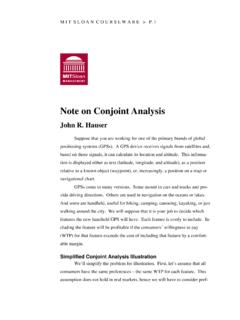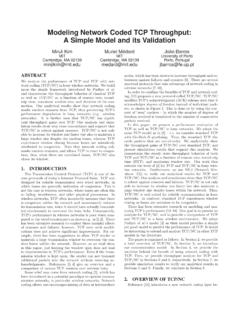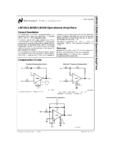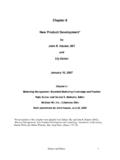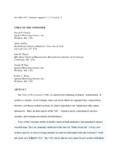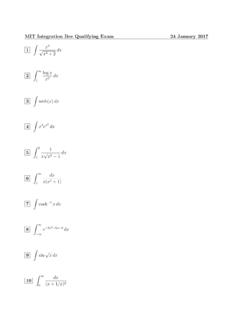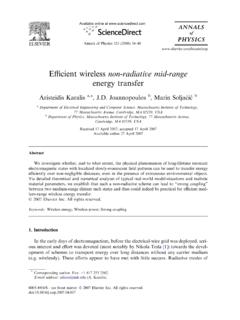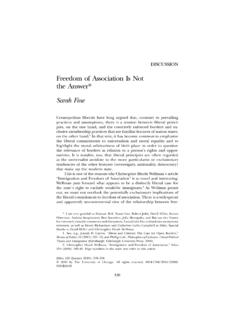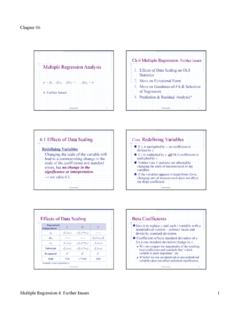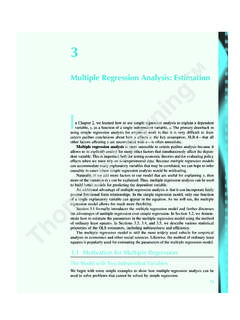Transcription of THE IMPACT OF 401(K) PARTICIPATION ON THE …
1 THEIMPACT OF 401(K) PARTICIPATIONON THEWEALTHDISTRIBUTION:AN INSTRUMENTAL QUANTILEREGRESSIONANALYSISVICTORCHERNOZH UKOV thispaper,we usetheinstrumentalquantileregressionappr oach developedin Chernozhukov andHansen(2001)toexaminethee ectsof 401(K) plansonwealthusingdatafromtheSurve y of (k)eligibilityas aninstrument for401(k) PARTICIPATION ,we estimatethequantiletreatment e ectsofparticipationin a 401(K) planon severalmeasuresof thee ectsof401(k)participationon net nancialassetsarepositive andsigni cant over theentirerangeof theassetdistribution,andthattheincreasei n thelow tailof theassetsdistributionappearsto translatecompletelyinto anincreasein ,thereis signi cantevidenceof substitutionfromotherformsof wealthin theupper tailof cation.
2 H31,C21,C31We wouldlike to thankJimPoterba,ByronLutz,DavidLyle,Ivan FernandezandWhitneyNeweyforhelpfulcommen ts arealsogratefulforcomments fromtwo anonymousrefereesandtheco-editorwhich substantiallyimproved thepresentationandcontent of theearly1980s,theUnitedStatesintroduceds everaltaxdeferredsavingsoptionsin ane ortto increaseindividualsavingforretirement. Thetwo optionswhich have generatedthemostinterestareIndividualRet irement Accounts (IRAs)and401(k) (k)plansaresimilarin thatbothallow theindividualto deductcontributionsfromtaxableincomeanda llow tax-freeaccrualof di erencesbetweenthetwo savingsoptionsarethatemployersprovide401 (k)plans,andemployersmay alsomatch a certainpercentageof anemployee' (k)plansareprovidedby employers,onlyworkersin rmso eringplansareeligibleforparticipation,wh ileparticipationin IRAsis open to is clearthat401(k)
3 Plansand,toa lesserextent, IRAsarewidelyusedasvehiclesforretirement saving,theirimpactonassetsis problemin de-terminingthee ectof participationin IRAand401(k)planson accumulatedassetsis saverheterogeneity coupledwithnon-randomselectioninto particular,it is generallyrecognizedthatsomepeoplehave a ,it seemslikelythatthoseindividualswiththehi ghestunobserved preferenceforsavingwouldbe mostlikelyto chooseto participatein tax-advantagedretirement savingsplansandwouldalsohave highersavingsin otherassetsthanindividualswithlower unob-servedsavingpropensity. Thisimpliesthatconventionalestimatesthat donotaccount forsaver heterogeneity andselectionof theparticipationstatewillbe biasedupward,tendingto overstatetheactualsavingse ectsof 401(k) thesavingsliteratureandhasledto numerousimportant studieswhich attemptto a seriesof articles,Poterba,2 Venti,andWise(1994,1995,1996)usecomparis onsbetweengroupsbasedoneligibilityfor401 (k) (k)eligibility canbe is motivatedby thefactthateligibility is determinedby theemployer,andso may be takenas ,Venti,andWise(1996)
4 Containsanoverviewof suggestive evidencebasedonpre-programsavingsusedto substantiatethisclaimandreportsmeanandme dianregressionestimatesof theimpactof 401(K) eligibility onhouseholdnet that401(k)eligibility hassigni cant andpositive e ectsonnet of 401(K) eligibility, theyattributethisdi erenceto thecausale ectof 401(K) eligibility workby Benjamin(2003)examinesthee ectsof eligibilityonsavingsusingmatchingbasedon thepropensity scoreand ndspositive, althoughmuchmoremodest,e ectsof 401(K) eligibility similarapproach, which we follow in thispaper,is thatof Abadie(2003).Abadie,assumingthateligibil ity fora 401(K) is exogenousgiven income(andothercovariates),uses401(k)eli gibility as aninstrument for401(k)participationin orderto estimatethee ectof401(k) PARTICIPATION ,noteligibility, onnet novel semipara-metricestimatorwhich estimatestheaveragee 401(K) canparticipate,theaveragee ectforcompliersalsocorrespondstotheavera gee 'sresultssuggestthattheaveragee ectforthetreatedof 401(K) participationis signi cant of all of thesestudiesis thattheyfocustheanalysison measuresof centraltendency.
5 Themeanor measuresin determininga program'simpact,theyarenotsu cient tofullycharacterizetheimpactof thetreatment exceptunderveryrestrictive ,theyareuninformative abouttheimpactof thetreatment on other,perhapsmoreinteresting,points in theoutcomedistributionwhenthetreatment e ectis 401(K) plansis especiallyinterestingfromapolicyperspect ive sincepolicymakersmay be particularlyconcernedabouttheimpactof401 (k)plansonthelower partof addition,knowledgeof thedistributionalimpactof a programprovidesa clearerpictureof whatis themeane ect,theanalysisof thedistributionale ectis compli-catedby thepossibility thatindividualschoosewhetheror notto participatein a 401(K) basedontheirunobserved wouldallow a morefullcharacterizationof thee ectof a heterogeneoustreatment given treatment exogeneity isthequantileregressionestimatorof Koenker andBassett(1978).
6 However,theself-selectionof theparticipationstatemakes thispaper,we contributeto theextensive setof existingliteratureof theimpactof401(k)plansonwealthby analyzingtheimpactof 401(k) Poterba,Venti, andWise(1994,1995,1996)andAbadie(2003)ou tlinedabove, we use401(k)eligibility as aninstrument for401(k)participationinorderto estimatethee ectof participatingin a 401(K) on variousmeasuresof dothis,we employ a modelandanestimatordevelopedin Chernozhukov andHansen(2001).Themodelprovidesa setof assumptionsunderwhich theconditionalquantilesof theout-comedistributionmay be recoveredfroma setof statisticalmoment equationsthroughtheuseof useis computationallyconvenient forlinearquantilemodelsandcanbe computedthrougha seriesof andHansen(2001)demonstratethattheestimat oris consistentunderendogeneity andtreatment e ectheterogeneity.
7 Thus,thispaper providesanim-portant complement to theworkdiscussedabove which focusesonestimatingtheimpactof 401(K) plansonthecenterof ,dueto thebinarynatureof boththeparticipationdecisionandtheeligib ility instrument, theapproach developedby Abadie,Angrist,andImbens(2002)to estimatequantilee ectsforbinarytreatmentsunderendogeneity present estimatesobtainedthroughbothproceduresto providebotha robustnesscheck anda comparisonof thetwo considerablehet-erogeneity in thee ectof 401(K) participationonnet nancialassets,withthetreatmente ectincreasingmonotonicallyas onemoves fromthelower to theupper tailof andsigni cant, suggestingthat401(k)
8 Participationpositivelyimpactsnet ectof participationontotalwealthis positive andapproximatelyconstant ,it is of thesamemagnitudeas thee ectof participationonnet nancialassetsforlow quantiles,butis substantiallysmallerthanthee ectof participationontheupperquantilesof net net nancialassetsobserved in thelower tailof theconditionalassetsdistributioncanbe interpretedasanincreasein wealth,whiletheincreasein theupper tailof thedistributionis mitigatedbysubstitutionwithsomeothercomp onent of ectof participationonnetnon-401(k) nancialassetsis uniformlyinsigni cant, which suggeststhereis littlesubstitutionfor401(k)assetsalongth isdimensionof thepaper is reviewsthemodelofquantiletreatment e ectsof Chernozhukov andHansen(2001)anddemonstrateshow anempiricalmodelforassetsmay be embeddedin Section3, presents theempiricalresultsandcomparestheresults fromtheestimatorof Chernozhukov andHansen(2001)to thoseobtainedwiththeestimatorof Abadie,Angrist,andImbens(2002),andSectio n5 Instrumental VariableModelfor QuantileTreatmentEffectsIn thefollowing,we brie ypresent theassumptionsandmainimplicationsof theinstru-mentalvariablesmodelof quantiletreatment e ectsdeveloped in Chernozhukov andHansen(2001).
9 We thenshow how anempiricalmodelof savingsdecisionsmay be theestimatesof themodel,especiallytheinterpretationof thequantileindex , andisolatesthekey Outcomesand the developed withintheconventionalpotential(latent) For example,Ydis anindividual'soutcomewhenD= valuesin a subsetDofRl. ThepotentialoutcomesfYdgarelatentbecause ,given theselectedtreatmentD, theobserved outcomeforeach individualor stateof theworldisY YD:Thatis, onlyonecomponent of potentialoutcomesvectorfYdgisobserved foreach featuresof thedistributionsof potentialoutcomesthatmay beinteresting,we focusonthequantilesof potentialoutcomesconditionaloncovariates X,7nQYd( jx); 2(0;1)o.
10 Andthequantiletreatment e ects(QTE)thatsummarizethedi erencebetweenthequan-tilesunderdi erent treatments ( (1974)):QYd( jx) QYd0( jx)or,if de ned,@@dQYd( jx):Quantiletreatment e ectsrepresent a usefulway of describingthee ectof treatmentdondi erent points of themarginaldistributionof selectedin relationtofYdginducingendogeneity, so thattheconditionalquantileofYgiven theselectedtreatmentD=d, denotedQY( jd; x), is generallynotequalto thequantileof potentialor latent outcomeQYd( jx). Thismakes theconventionalquan-tileregressioninappr opriatefortheestimationofQYd( jx). Themodelof Chernozhukov andHansen(2001),brie ypresentedbelow,statestheconditionsunder which we canrecoverthequantilesof latent outcomesthrougha setof conditionalmoment Quantile Treatment buildthemodelfromthebasicSkorohod representationof latent outcomesYd, which yieldsforeachdgivenX=xYd=q(d; x; Ud);whereUdd U(0;1);( )andq(d; x; ) =QYd( jx) is theconditional -quantileof latent essentialto therestof responsibleforheterogeneity of outcomesforindividualswiththesameobserve dcharacteristicsxandtreatmentd.
